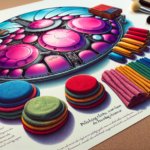Published: October 2023
The handpan is a beautifully unique instrument that has captivated musicians and listeners alike since its introduction. Often referred to as a “sound sculpture,” the handpan produces melodic and harmonic tones that can evoke deep emotions and a sense of tranquility. However, choosing the right handpan can be a daunting task, especially if you are a beginner or have limited experience with the instrument. This article aims to provide essential tips to help you choose the perfect handpan that suits your needs and preferences.
Understanding What a Handpan Is
A handpan is a musical instrument that belongs to the idiophone family. It is made from two metal half-shells that are glued together to create a resonant chamber. The top shell, known as the “ding” side, has a central note, which is surrounded by a number of tone fields. The bottom shell, often called the “gu” side, typically has a central hole that allows sound to escape.
Handpans are played by striking or gliding over the tone fields with the hands and fingers, producing a rich array of sounds and overtones. The number and arrangement of tone fields can vary, affecting the musical range and complexity of the instrument.
Consider the Quality of Materials and Craftsmanship
The quality of materials and craftsmanship is crucial when choosing a handpan. Since handpans are hand-made instruments, the consistency of their build can vary significantly from one maker to another. Here are a few aspects to consider:
- Material: Handpans are typically made from nitrided steel, stainless steel, or raw steel. Each type of material has its characteristics that affect the sound quality, sustain, and resistance to rust.
- Construction: Look for a well-constructed handpan with smooth finishing, even tone fields, and a clean central note. Poor construction can lead to tuning issues and a lack of harmonic balance.
- Tuning: A high-quality handcrafted handpan will maintain its tuning for a long time. Ensure that the instrument is well-tuned, as even minor discrepancies can affect the overall sound experience.
Choosing the Right Scale
One of the most exciting yet overwhelming aspects of choosing a handpan is selecting the right scale. The scale determines the musical notes and the overall mood of the instrument. There are many scales to choose from, each with its unique set of characteristics. Some popular scales include:
- D Minor (Celtic): Known for its melancholic yet soothing quality, this scale is versatile and widely loved among handpan players.
- Integral: This scale consists of both major and minor notes, offering a range of emotions and a harmonious sound.
- Ake Bono: A pentatonic scale that offers a traditional and meditative sound, often found in Asian music.
- Hijaz: Known for its exotic and mysterious tonality, this scale has roots in Middle Eastern music.
When choosing a scale, consider the type of music you wish to create and the emotional response you seek. Listening to recordings of different scales can also help you make an informed decision.
Understanding the Importance of Note Layout
The note layout on a handpan can significantly affect its playability and the ease with which you can create music. Note layouts can vary, so finding a design that suits your playing style is crucial. Here are a few popular note layouts:
- Symmetrical: Notes are arranged symmetrically around the central note, making it easier to find and play patterns.
- Diatonic: Notes follow a diatonic scale, making it easier to play melodies and harmonies.
- Mixed Layout: A combination of different note arrangements can provide greater flexibility and a broader musical range.
Experiment with different layouts to find the one that feels most comfortable and intuitive for your playing style.
Testing and Buying Your Handpan
Once you have narrowed down your options based on quality, scale, and note layout, the next step is testing the handpan. If possible, try to test the instrument in person to get a feel for its sound and playability. Here are a few tips when testing a handpan:
- Check for any buzzing or unwanted overtones, as these could indicate a flaw in the construction or tuning.
- Play each note individually and listen for clarity and consistency in sound.
- Test the sustain of the notes to ensure they resonate well without fading too quickly.
- Consider the overall comfort and ease of playing the instrument.
If you are buying a handpan online, make sure to buy from reputable sellers or manufacturers. Look for reviews and testimonials from other buyers and, if possible, request sound samples or videos of the specific handpan you are interested in. Many manufacturers also offer return or exchange policies, providing added security when making your purchase.
Setting Your Budget
Handpans can be quite an investment, with prices ranging from a few hundred to several thousand dollars. Setting a budget beforehand can help narrow down your options and ensure you find an instrument that offers good value for money.
While it may be tempting to opt for cheaper models, keep in mind that lower-priced handpans may not offer the same quality or longevity as higher-end instruments. It is often worth saving up for a high-quality handpan that will provide a better playing experience and maintain its value over time.
Taking Care of Your Handpan
Once you have chosen the perfect handpan, proper care and maintenance are key to ensuring it stays in good condition for years to come. Here are a few tips for taking care of your handpan:
- Clean your handpan regularly with a soft, dry cloth to remove any dirt or fingerprints.
- Avoid exposing the instrument to extreme temperatures or humidity, as this can affect the tuning and materials.
- Use a protective case or cover to prevent damage when transporting or storing your handpan.
- Avoid using any harsh chemicals or abrasive materials to clean the handpan, as these can damage the surface and affect the sound quality.
- Periodically check the tuning and, if necessary, consult a professional handpan tuner for adjustments.
Connecting with the Handpan Community
Finally, connecting with other handpan players and enthusiasts can be incredibly valuable as you continue your journey with this beautiful instrument. Engaging with the handpan community can provide support, inspiration, and opportunities to learn and grow as a musician. Here are a few ways to get involved:
- Join online forums and social media groups dedicated to handpan players.
- Attend handpan workshops, concerts, or gatherings to meet other musicians and exchange ideas.
- Follow handpan artists and makers to stay updated on new developments and trends in the handpan world.
Being part of a supportive community can enhance your playing experience and provide endless opportunities for musical exploration.
Conclusion
Choosing the perfect handpan is a highly personal and rewarding process that involves careful consideration of various factors, including materials, craftsmanship, scale, note layout, and budget. By following the tips outlined in this article, you can make an informed decision and find an instrument that resonates with you both musically and emotionally. Remember that the journey with your handpan doesn’t end with the purchase; proper care and engagement with the handpan community will ensure that your musical experience continues to grow and evolve over time.
FAQs
1. What is the difference between a handpan and a hang drum?
While the terms “handpan” and “hang drum” are often used interchangeably, the hang drum specifically refers to the original instrument created by PANArt, a Swiss company. Handpan is a more general term that encompasses a variety of similar instruments created by different makers.
2. How often should I tune my handpan?
The frequency of tuning depends on how often you play and the conditions in which you store your handpan. Generally, tuning every 1-2 years is sufficient, but consult with a professional tuner if you notice any discrepancies in sound.
3. Can handpans be custom-made?
Yes, many handpan makers offer custom-built instruments, allowing you to choose specific scales, materials, and note layouts. Custom-made handpans can be more expensive but provide a highly personalized playing experience.
4. Are handpans difficult to play?
While handpans are relatively easy to start playing, mastery requires practice and dedication. The intuitive layout and soothing sound make it accessible for beginners, but advanced techniques and compositions can pose a challenge for more experienced players.
5. Can I travel with my handpan?
Yes, handpans can be transported, but it is essential to use a protective case to prevent damage. Be mindful of temperature and humidity changes when traveling, and ensure that the handpan is secure during transit.





